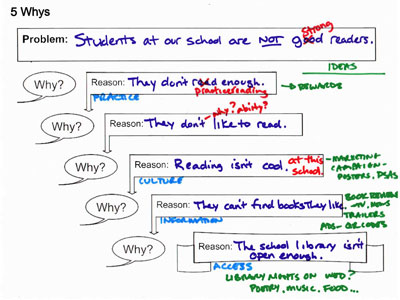

Many educators are using a design-thinking approach to connect learning to life outside the classroom and to help build skills necessary for success in our rapidly changing world.
In design thinking, students work to develop a solution to a problem faced by a specific person or audience. During the process, students develop empathy as they look at a problem through someone else’s eyes. They learn to identify problems, break them down, and brainstorm new ideas; working together to develop a solution that capitalizes on the skills and strengths of their teammates.
“Design Thinking is all about building creative confidence — a sense that ‘I can change the world.’” Maureen Carroll
Most educators use a design process to give structure to student work. The Engineering Design Process, developed by the Museum of Science in Boston, involves five stages:
Rather than having students design an infographic, poster or training video, ask students to design for a purpose and give them voice and choice in choosing which product meets that purpose. Here are some ideas for designing with a purpose.
Asking students to invent something to solve a problem is how a design process is commonly used in classrooms and maker spaces.
Design challenges that arise out of a problem help to focus student efforts toward innovation and can often be connected to the curriculum. For example, you could present students with a problem like:
Too much cafeteria food is going to waste! How can we reduce it?
Students might then choose to:
Ask students to complete an Empathy Map to identify specific challenges their audience faces. Use a Five Whys organizer to help students identify cause and effect behind problems and process. The Five Whys methodology originated with the Toyota Motor Corporation, who developed the process to help their engineering teams determine the root cause of problems.

Students have amazing talents and have worked hard in school to gain expertise in a range of areas. Ask students to design something that helps others benefit from this expertise. For example, students could design a guide to surviving the gold rush or create a public service announcement about severe weather safety.
The easiest way to connect a design process to the curriculum is to link it to a specific standard or learning goal. California educator, Katy Hammack, took this to heart when she and her third-grade students were exploring informational text. As they learned how to use the features of nonfiction to find information, she tasked her students with creating an eBook to share their own experience or expertise.
While each student created the same product (eBook), the content of their work varied from ice cream, to off-road vehicles, to surviving leukemia.
Give students a cluster organizer to help them come up with details they can use to share their expertise. If they are having trouble choosing a direction, provide a topic (to connect more closely to classroom content), and ask them to complete a Think-Puzzle-Explore organizer.
Teaching content to others is an effective classroom practice for helping students master content. Because they are working to help other students, many students work harder to master the material.
For example, if a student has a problem remembering a specific grammar rule or the order of operations for solving equations (PEMDAS), ask them to create a tutorial that teaches others about the rule and how to apply it.
It also easy to connect this sort of design challenge to expository writing standards. When students want to learn something new, where do they go? YouTube! Ask them to create a how-to tutorial to teach someone the steps in a task they love to do.
Students can use a Flowchart or Cycle organizer to identify steps before designing their how-to instructions, whether they choose to create a tutorial, manual, comic or other type of informational text.
While this can be as obvious as how to ride a bike or how to make a peanut-butter and jelly sandwich, students could also tie this to social emotional learning to share how they are good at including others, giving quality compliments, and making friends.
Students want to do work that has value outside of the classroom. Designing to raise awareness gives a purpose to their work that goes beyond academic understanding.
For example, you could ask students to design a media campaign around the digital citizenship topic that most interests them. As they work to inform others, students choose the product they will create based on their audience or topic.
Use a Plus-Minus-Interesting or Ways of Thinking organizer to help students approach an issue and audience from a range of perspectives to better address how to inform them and encourage them to take action.
Asking students to design to change behavior is more complex than simply informing or raising awareness. The assumption that people will change their behavior when presented with facts and information, isn’t the way it usually works in reality.
Changing behavior requires a combination of argument and persuasive writing. While you don’t want student work to be propaganda, it is often helpful to explore techniques of propaganda to give them ideas for ways to persuade others. Exploring how these techniques are used also has the side benefit of helping students become more savvy media consumers.
If students are designing to change behavior, be sure to give them complete control over choosing their issue. While some students will be able to construct effective arguments for any topic, tapping into student passion helps provide students with the motivation necessary to do the research and thinking necessary to effect real change.
Students can also choose from a range of products like posters, infographics, and public service announcements to meet their purpose.
Get students thinking about which evidence to use to support their arguments by using OREO (opinion, reason, example, opinion) and Pros and Cons organizers.
Giving purpose to student design projects motivates learners to do the hard work of research and thinking necessary for success. As they work collaboratively to solve problems, share expertise, teach, raise awareness, and change behavior, they gain the skills necessary to make our world a better place, now and in their future.

Follow us on Instagram for daily inspiration

Create a thought web, cluster, flowchart, or other graphic organizer for a lesson
8 first projects to get students using technology
Creative, digital book reviews
Fun and powerful ideas with animated characters

Wixie
Share your ideas, imagination, and understanding through writing, art, voice, and video.

Rubric Maker
Create custom rubrics for your classroom.

Pics4Learning
A curated, copyright-friendly image library that is safe and free for education.

Wriddle
Write, record, and illustrate a sentence.

Get creative classroom ideas delivered straight to your inbox once a month.
Topics